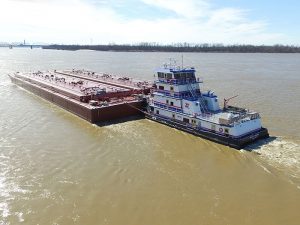
Golding Barge takes delivery of second triple-screw towboat
Now in service with Golding Barge Line Inc., of Vicksburg, Miss., the M/V Rusty Moore is the second of two 94-foot, triple-screw towboats built for the company by Master Boat Builders of

Now in service with Golding Barge Line Inc., of Vicksburg, Miss., the M/V Rusty Moore is the second of two 94-foot, triple-screw towboats built for the company by Master Boat Builders of
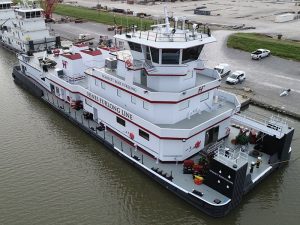
Belle Chasse, La., based C&C Marine and Repair recently delivered the triple-screw 6,600-horsepower towboat M/V Scarlett Rose Furlong to Nashville, Tenn., based Hines Furlong Line Inc. Measuring 170 feet by 50 feet
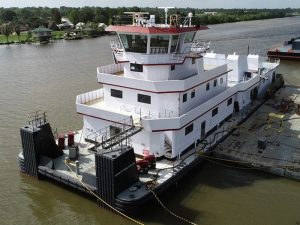
C&C Marine and Repair LLC, Belle Chasse, La., is putting the final touches to the 6,600 hp, 170- by 50-foot towboat M/V Scarlett Rose Furlong. Set to be delivered by mid-September to
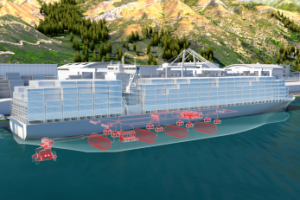
Buying Time With LNG While LNG may not be zero carbon, it is arguably the cleanest currently available fuel delivering a significant reduction in GHG emissions. At the start of this year,
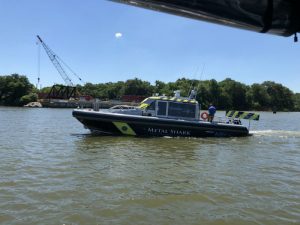
JULY 29, 2018 —The Multi-Agency Craft Conference (MACC) offers an annual glimpse into the future of the U.S. military and government agency patrol boat market, creating a valuable opportunity for marine suppliers

APRIL 5, 2018 — RAD-Power, Beaconsfield, Quebec Canada, has been named a new manufacturer’s representative for the Eastern and Central regions of Canada including the Atlantic provinces of Newfoundland, Nova Scotia, Prince
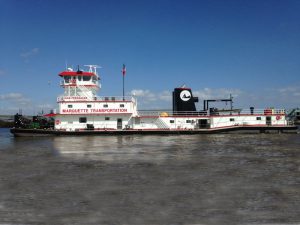
OCTOBER 18, 2016—This past September, the Houma, LA, shipyard of Gulf Island Shipyards, a division of Gulf Island Fabrication, Inc., delivered the 10,000 hp M/V Chad Pregracke, the last of a series
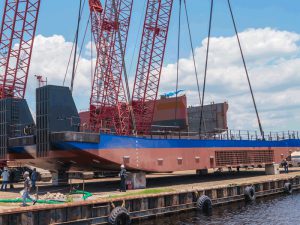
Independent commodity trader Trafigura Group, through its subsidiary Impala, is investing $1 billion in creating the infrastructure for a new multimodal supply chain in Colombia that can transport crude, naphtha, break-bulk cargo, containers, and oversized cargo up and down the country’s main waterway, the Magdalena River.
Impala Colombia currently operates a terminal in the seaport of Barranquilla, where the Caribbean Sea meets the Magdalena River. Some 630 kilometers south of Barranquilla on the Magdalena River, Impala is investing some $450 million in developing a new state-of-the-art inland river port in Barrancabermeja. The inland river port will have an oil terminal with six tanks that can store 120,000 bbls each and a general cargo and container terminal. The port will serve as an intermodal connection between river transport and truck transport. Impala’s fleet of barges will ship product to and from major crude oil production sites as well as major cities such as Bogotá or Medellin.
In addition, Barrancabermeja will also serve as a seaport with bills of lading possible to connect directly with international ports such as Rotterdam or Shanghai.
Part of Impala’s investment includes a fleet of new towboats and barges. Impala’s growing Colombian fleet includes at least 15 new towboats and 68 liquid barges and 45 dry cargo barges. The tank barges are double hulled, with vapor recovery systems for environmental responsibility and safety and can carry up to 10,000 barrels of oil.
This past summer, Eastern Shipbuilding, Panama City, FL, launched the Impala Soledad and Impala Puerto Salgar, the first two in a series of four inland river towboats for IWL River Inc., an affiliate of Impala Terminals Colombia.
Designed by CT Marine, the towboats are are being built to ABS Class Inland River Service. Eastern Shipbuilding expects to finish delivering the boats in 2017.
Impala Soledad and Impala Puerto Salgar along with the other sister vessels in the series, the Impala Mompox and Impala Catagallo, will each be 134 feet long, 42 feet wide, with a depth of 9 feet and minimal operational draft of 6 feet.
Each towboat will be triple screwed, with three Caterpillar 3512C main diesel engines, certified to IMO Tier II. Each will produce 1,280 hp at 1,600 rev/min for a total of 3,840 hp. Karl Senner, Kenner, LA, supplied the three Reinjtes WAF665 reduction gears.
The towboat’s auxiliary power is supplied by two Caterpillar C6.6 125 kW, 220-volt, 3-phase main generators.
The Panama flag vessel will be classed ABS +A1, Towing Vessel, River Service, +AMS, ABCU.
CT Marine also designed the towboats to have a retractable pilothouse. When fully raised, the pilothouse will have a 37 foot 6 inch eyelevel above the waterline. Towboats designed with retractable pilot houses can pass under low fixed bridges along their route. The deckhouse is confined to a single level and only the pilothouse is extended atop a hydraulic ram. When raised, the pilothouse provides excellent visibility for the master to see over top his tow.
NEW TOWBOAT FOR FMT
Another new towboat built with a retractable pilothouse was Florida Marine Transporters’ M/V Marty Cullinan. Built by Horizon Shipbuilding, Bayou La Batre, AL, the M/V Marty Cullinan has an ABS Load Line Certificate to operate in the waters between Chicago to Burns Harbor for fair weather voyages.
The 387 gt towboat is outfitted for service in areas with restricted overhead clearances and draft limitations. With the pilothouse fully retracted, the maximum air draft is 17 ft 8 in.
The 120 ft x 35 ft x 11 ft 6 in vessel is of all steel construction and powered by two Caterpillar 3512 engines, each rated at 2,011 hp at 1,600 rev/min with Twin Disc gears. The boat is outfitted with two 175 kV Tier 3 John Deer 6090 460 V gensets.
Sleeping accommodations and facilities are provided for eight persons and sound dampening systems have been implemented throughout the main deck house.
The towboat was built in 14 months. Project Manager Terry Freeman, who managed the construction of the vessel, said, “Our team exceeded all expectations with regard to the timely production and quality work on this build especially given the new design, ABS requirements and technical expertise required for the retractable pilot house.”
Jeff Brumfield, Senior Manager of Boat Construction and Engineering for FMT said, “We are thoroughly pleased with the boat, and when I talk to the Marty Cullinan crew they are quick to note that she is smooth and very quiet. The sound dampening package has exceeded our expectations.”
“We have worked hard to build one of the best boats on the river and we consider ourselves fortunate to have teamed with FMT and John J. Gilbert to do this,” said Travis Short, President of Horizon Shipbuilding. “Horizon has been building FMT boats for almost a decade and in that time we have been able to assemble a team of master craftsmen that produce a superior product. All the praise goes to those men and women in the yard, taking care to do the job right the first time while working safe, working hard and working together.”
Horizon has two more 120 ft FMT towboats, one standard and the other with a retractable pilothouse, in production with deliveries scheduled for this fall and the spring of 2017.
“LADY” KEEPS ON KEEPING ON
The M/V Lady Loren doesn’t have a retractable pilothouse, but does have a raised one that provides an eyelevel of 35 feet above the waterline. Back in 2008, LA Carriers built the pusher tug Lady Loren at Lockport Fabrication. At the launch, LA Carriers President Russell Plaisance explained that the boat was the result of five years of planning and a lifetime of maritime experience in the Gulf of Mexico. The 82 ft x 28 ft Lady Loren was the seventh boat in the LA Carriers fleet.
For Plaisance at the time, a key element of his business was diversification. “We do $10 million to $11 million [in gross revenue] per year including some business with the oil industry,” he said, “but we do a little of everything else as well. We barge pipe and we once even towed baseball dirt from Houston to Tampa Bay for spring training. This new boat has a contract to tow corn syrup from Memphis to Tampa Bay.”
Now eight years later, the corn syrup contract has dried up—the plant has been converted to other products. But LA Carriers’ diversity has kept the company healthy even during the current slump in the oil industry.
The Lady Loren, with both towing and pushing capabilities, is currently engaged moving a pair of hopper barges on a run between New Orleans and Tampa.
The Lady Loren is a triple-screw tug powered by three Cummins QSK19-M3 diesels rated at 660 hp each to give a total of 1,980 hp. The engines turn three 63 by 67-inch propellers in kort nozzles.
“The engines had 36,000 hours on them so I decided to rebuild the middle engine,” says Plaisance. “Without removing the engine, my crew, together with Cummins mechanics replaced the shaft bearings, pistons and rods, heads and injectors. When we looked at the wear on the parts that came out of the engine we realized that they could easily have given us another 4,000 hours with no risk of down time.”
As a result, he feels confident in leaving the rebuild of the two outside engines for another year by which time they will have a remarkable 40,000 hours each. Crediting Cummins quality, Plaisance also has a very proactive service and maintenance program on the engines. Oil is changed regularly, and injectors adjusted every 10,000 hours.
LA Carriers has changed some of the fleet in the eight years since the Lady Loren was first launched and they have several different engine makes among its seven boats. Plaisance is unreserved in his praise for the Cummins engines. “In future, if I have to replace an engine in one of my other tugs, it will be with Cummins,” he says.
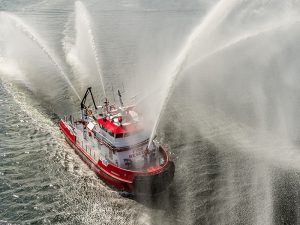
SEPTEMBER 2, 2016 — Vigor’s Seattle, WA, shipyard recently delivered an 88′ x 25′ x 14′ state-of-the-art fireboat to the San Francisco Fire Department. Designed by Jensen Maritime, it is the first
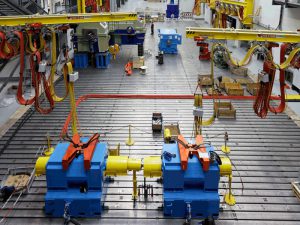
Vessel operators are still very much focused on reducing fuel consumption and lowering emissions. Collaboration early on in the design of a new vessel and its construction between the vessel owner, naval architects, shipbuilders, and propulsion manufacturers can payoff in optimizing the vessel’s hull, reducing costs of construction, and lowering operational costs during a vessel’s lifetime.
“We work with naval architects early in the design process to help optimize the propulsion system, looking to meet all design requirements while minimizing the size and horsepower of the system,” says Elizabeth Boyd, PE, President, Nautican Research & Development Ltd. Boyd says collaboration early in the design phase “can result in significant savings because if the horsepower can be reduced due to efficiency gains, it can lead to size reductions in not just the horsepower and propellers, but also everything that goes along with it—shafts, bearings, etc.—sometimes it can even mean meeting the requirements with a smaller boat. We can quickly show performance and full system configuration for different sizes, allowing the naval architect to explore options very quickly.”
Nautican’s foundation was built on efficiency. More than 40 years ago, company founder Josip Gruzling pioneered the use of hydrofoils to increase the efficiency of tugs and barges. Today, Nautican engineers and manufactures hydrodynamic solutions, including patented Integrated Propulsion Units, High efficiency nozzles and propellers, high aspect ratio triple rudders, pre-swirl stators, and also hydralift skegs for barges. It says independent tests show that its propulsion system solutions increase power and maneuverability, while significantly reducing fuel use and maintenance needs.
One of the Nautican’s latest projects is fabricating the first two sets of 104-inch nozzle units for the 120 ft Kirby Offshore Marine line haul tugs under construction at Nichols Brothers Boat Builders, Whidbey Island, WA.
According to Boyd, initially nozzle development was done using both Computational Fluid Dynamics (CFD) and physical testing in a cavitation tunnel and towing tank. “However,” she says, “our CFD efforts now are focused more on integration with the hull form. For these boats, CFD was not used as the design was already well developed and fairly straight-forward as far as placing the nozzles.”
The designer of the ABS Class tugs is Jensen Maritime, Crowley Maritime Corp.’s Seattle-based naval architecture and marine engineering company.
Each of the two tugboats will be equipped with two Caterpillar 3516C main engines, rated at 2,447 hp at 1,600 rev/min. Reintjes reduction gears, supplied by Karl Senner, LLC, Kenner, LA, will turn two Nautican fixed-pitch propellers with fixed nozzles. Other equipment onboard the tugs will include two C7.1 Caterpillar generators for electrical service, one TESD-34 Markey tow winch, one CEW-60 Markey electric capstan and one Smith Berger Town Pin.
“Kirby owns many boats with Nautican systems, but most of these have been ATBs (Articulated Tug Barge units) to date,” says Boyd. “We worked recently with Nichols on a pair of Kirby 10,000 hp ATB tugs—this project went very well and these vessels are performing exceptionally well in service.”
Nautican designed larger 120 inch nozzle units for another tug for Dunlap Towing. “Dunlap is a Nautican repeat customer,” says Boyd. The new tug, says Boyd is a new design, based on the Phyllis Dunlap, but “fully rethought and redesigned by Hockema Whalen.”
The 5,000 hp, twin-screw tug Phyllis Dunlap was built in 2001 by Hansen Boat Company, Everett, WA.
“Dunlap has been a great customer to work with—they are very involved in all aspects of the design and equipment selection and are very knowledgeable, providing some really useful feedback about performance over the years in their very demanding runs to Hawaii and Alaska.”
Wärtsilä Transverse Thruster
Earlier this year, Wärtsilä expanded its transverse thruster series with the addition of the Wärtsilä WTT-40, with a 4,000 kW power level and a 3,400 mm diameter controllable pitch propeller. While Wärtsilä has designed and built customized transverse thrusters as powerful as 5,500 kW, the WTT-40 and others in the WTT range address customer needs for high power transverse thrusters for bow and stern applications.
Development work on the Wärtsilä WTT-40 began in 2015 with an eye on targeting cruise ships, large OSVs and offshore construction vessels. The high power level is particularly important for the harbor maneuvering and docking of large ships, and for dynamic positioning of offshore vessels working in heavy sea conditions.
Because of its maximum power of 4,000 kW, shipyards and cruise vessel designers have the option of using three WTT-40 thrusters instead of four smaller ones. This translates into a more efficient vessel design with less space required for the transverse thrusters. It also allows thrusters to be installed closer to the bow where they are more effective.
Wärtsilä’s extensive experience with propeller design and tunnel optimizations using CFD analysis, ensures an optimal solution when it comes to propulsion performance, efficiency, and the minimization of noise and vibration.
Another benefit of the Wärtsilä WTT-40 is its integrated hydraulics, which save machinery room space and installation and commissioning time at the shipyard.
Innovative ship propulsion systems made by RENK
Military vessels such as patrol boats, corvettes, and frigates looking for “silent running” might well be interested in the Renk Advanced Electric Drive AED. The new drive from the Augsburg, Germany, plant offers a number of special advantages for shipbuilders, says Renk. The propulsion system is a real alternative to the heavy, space consuming electric motors that are rotating at propeller speed.
Modern power electronics allow the use of high-speed motors in combination with an efficient gearbox. The Renk AED combines electric motor and gearbox on one joint frame. Built on soft elastic mounts and equipped with a highly elastic propulsion coupling an incomparably silent operation is possible. The water-jacket of the water-cooled electric motor as well as the double helical reduction gear add to extremely low noise operation.
A modularized lightweight
Thanks to the compact design as well as the low height the preassembled unit is quickly installed with minimum space requirements. Additionally there is a considerable weight advantage. The drive weights around 40% less than a conventional direct drive motor. By comparison, the Renk AED weighs only 23 tons instead of the 35 tons of a direct drive motor of the same power.
Suitable for fixed pitch propellers as well as controllable pitch propellers the drive speed can be flexibly adjusted to the respective propeller requirements. The propulsion systems is built modularly and can be delivered in four sizes from 1.4 to 6 MW. For uses where the requirements are between sizes RENK simply adjusts the capacity of the bigger engine. In this way the complete range of capacities can be covered individually and economically. The motors work with low or mid ranged voltage and are designed –depending on size- for propeller revolutions of 190-450 rev/min.
Investing in new production & testing facilities
Besides pouring millions of dollars into research and development, marine propulsion manufacturers are also investing in new production and testing facilities. Earlier this year, Renk opened one of the largest and most modern test facilities in Europe for gear units at its headquarters in Augsburg. Whether for the shipbuilding, automobile or industrial sector: The multifunctional test facility is especially suitable for the testing of prototypes or special equipment. Renk will not only test its own special gearboxes and propulsion systems, but also those of other propulsion systems or propulsion component manufacturers. The test facility allows for a power capacity of up to 12 MW at 10 revolutions per minute and can take a torque of up to 11 million Nm.
 Just this past June, Rolls-Royce Marine unveiled plans for a EURO 57 million plan to upgrade its azimuth thruster plant in Rauma, Finland, and consolidate its thruster assembly and testing to one site.
Just this past June, Rolls-Royce Marine unveiled plans for a EURO 57 million plan to upgrade its azimuth thruster plant in Rauma, Finland, and consolidate its thruster assembly and testing to one site.
Rauma produces a wide range of mechanical azimuth thrusters for use on a wide range of applications including semi-submersible drilling rigs and drillships, tugs and offshore vessels. Rauma also produces thrusters for specialist vessels such as icebreakers and polar research ships.
Mikael Makinen, Rolls-Royce, President – Marine, says, “Our azimuth thrusters are one of our most important products, providing mission critical power and propulsion for some of the largest floating objects on the planet. To be able to make this significant investment in Rauma not only prepares us for future growth in this market, but is a vote of confidence in the capability and expertise of our people.””
Azimuthing thrusters rotate through 360 degrees, providing propulsion and maneuverability without the need for a rudder. The largest and most powerful thrusters from Rauma are the ARC type which power icebreakers including the Finnish vessel Fennica. They are among the largest products produced by Rolls-Royce and can each weigh up to 190 tonnes, providing 7.5Mw of power.
Two of the world’s largest floating structures are powered by another range of thrusters produced in Rauma, UUC underwater mountable thrusters:
The heavylift vessel Pioneering Spirit, owned by Allseas, which is used for decommissioning oil platforms, has13 UUC thrusters; and Shell’s Prelude, the world’s first floating LNG production facility, will feature three large UUC thrusters, for position keeping. The thrusters are installed in a novel arrangement that allows them to be removed and maintained within the ship.
The work to transform Rauma will begin immediately and is due for completion in 2020. The investment will include installation of a crane capable of lifting 200 tons, and at least six factory acceptance test rigs. Offices and IT systems will also be refurbished.